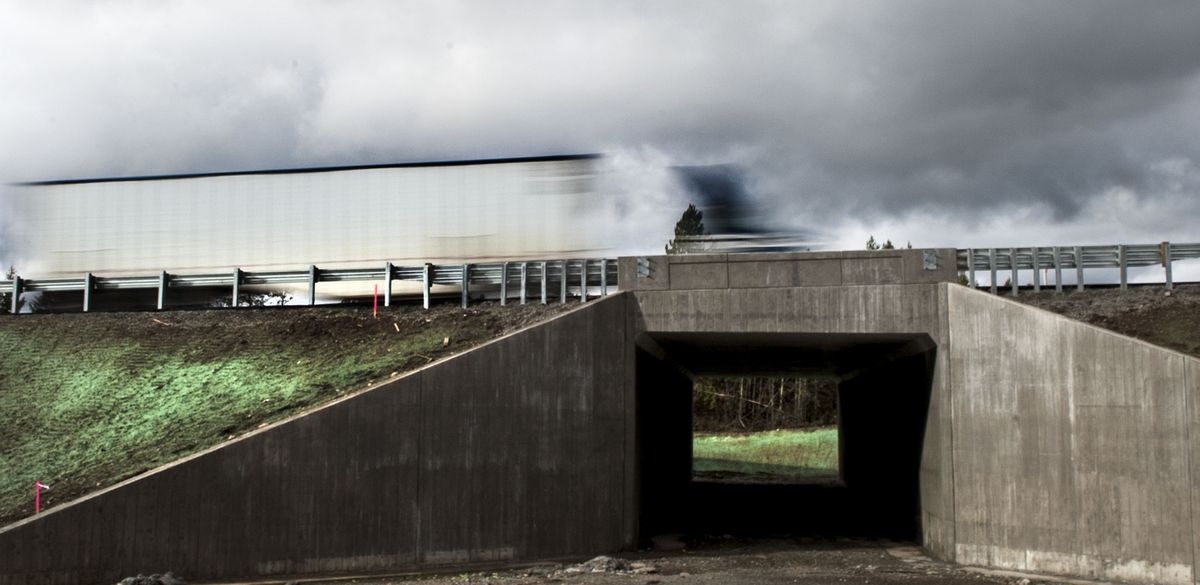Rise in deer-car collisions concerns Idaho officials

More than 5,000 deer, elk and moose were killed by cars on Idaho’s roads last year, a number so high that Fish and Game officials are worried about impacts on hunting and are ramping up monitoring and wildlife crossing programs.
“Right now, we think we’re losing the same number of deer that we harvest in our biggest deer unit every year, so that is significant,” said Gregg Servheen, wildlife program coordinator for Idaho’s Fish and Game Department. “As we try to maintain deer harvest and sportsman interest and opportunity, that becomes key.”
And it’s why a new section of U.S. Highway 95 being built north of Coeur d’Alene features a $1 million wildlife underpass, designed to allow deer, elk, moose, bears and other critters to cross freely – without endangering either themselves or the motorists whizzing by on the state’s main north-south route. Extensive fencing will route the animals to the safe crossing.
The underpass, just south of Silverwood, will be the state’s fifth when the highway project is completed next fall. Another that was built on Highway 21 east of Boise in 2011 has seen large herds of deer crossing safely as car-deer collisions at the site plummeted.
Three were built in the Eastport area in 2004, on Highway 95 in Boundary County, as part of a 16-mile highway realignment project.
That’s a particularly dangerous area, and this is the most dangerous time of year for deer-vehicle collisions.
“In November at dawn or dusk, it’s pretty darn dangerous,” said Brent Thomas, a geographic information systems analyst with Idaho Fish and Game. “There’s a lot of deer.”
Nearly 900 animals, most of them white-tailed deer, were hit by cars on Highway 95 from just south of Coeur d’Alene to the Canadian border in 2011, according to Fish and Game data. There also were moose, elk, bears and others.
Fish and Game officials say likely only about 50 percent of road-killed animals are reported, so the numbers could be twice as high as their reports show.
Idaho’s attention to wildlife crossings in recent years has lagged behind some neighboring states. Montana, for example, built more than 40 wildlife crossings, including underpasses and one large overpass, on a 56-mile stretch of U.S. Highway 93 in 2010. Utah has spent more than $47 million on wildlife crossings since 2005, and Wyoming has spent $20 million since 2001.
“We see a lot of needs,” Servheen said. “Mule deer… are in decline. It’s a very important species here in Idaho, because we have a lot of mule deer hunters. Roadkill, we think, is one of the principal impingements on mule deer populations and mule deer health.”
State Farm Insurance ranked Idaho 33rd in the nation for chance of deer-vehicle collisions in 2011-’12, classifying the state as “medium risk,” while Washington ranked 43rd, or low-risk. The highest-risk states include West Virginia, No. 1, and Pennsylvania, which was fourth, along with a group of northern and midwestern states including South Dakota, which ranked second, and Montana, which ranked sixth.
Washington’s estimated number of deer-car collisions is nearly twice Idaho’s. But because it has nearly five times as many drivers, the risk per driver is much lower.
Washington has built at least five wildlife underpasses, the first two in 1974 on Interstate 90 near North Bend, and has major ones in the works as part of a big Snoqualmie Pass highway project on I-90.
Kelly McAllister, wildlife biologist with the Washington State Department of Transportation, said that although Washington has fewer problems with deer than many states, it does have problems with elk and moose, which, because they’re larger, can be more damaging.
“I-90 had a fatality collision (involving a moose) between Spokane and Stateline four years ago,” McAllister said. “It’s been a recurring problem, and we’re looking at fencing I-90 to keep moose and other animals, deer and elk, from getting onto the highway.”
No underpasses are contemplated there, because the bridge over the Spokane River just across the Idaho line already “provides a really good opportunity for those animals to move safely under that highway,” McAllister said.
Idaho Fish and Game over the past several years has created an extensive mapping system highlighting major wildlife crossings on roads statewide, and is coordinating with the Idaho Transportation Department to consider those in future road construction projects.
“Wildlife collisions are a threat to human safety and wildlife survival,” said Jeff Stratten, spokesman for the ITD. “Wildlife tunnels have proven to reduce collisions with both large wildlife, such as deer and elk, and smaller animals such as foxes and raccoons.”
State Farm reported, based on its claims data, that the average deer-vehicle collision in 2011-2012 caused $3,305 in property damage. It also noted that its deer-related claims have increased 7.9 percent in the past four years, while other similar auto claims declined 8.5 percent.
Crossings and fencing make a noticeable difference, Servheen said. “It keeps them off the road, and it funnels them into the area where they need to go.”
McAllister, in Washington, said, “There is definitely an increased awareness all around the country that these kinds of structures are effective. They’re used by wildlife. They do reduce collisions, particularly when you combine it with good-quality barrier fencing, and in the long run, they pay for themselves, really, in terms of reduced property damage from collisions.”